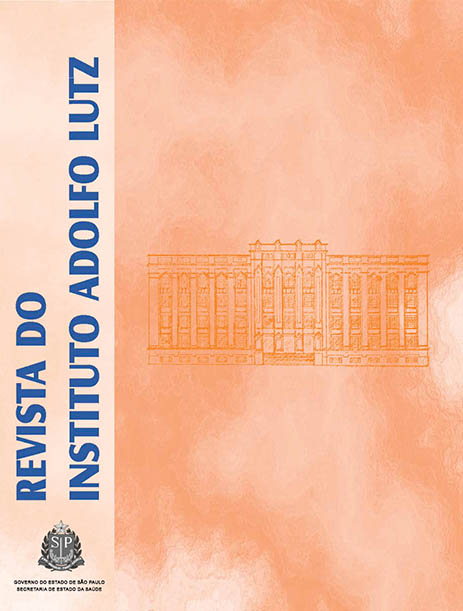Abstract
According to the Brazilian legislation the sterile pasteurized milk and the milk powder should not contain cheese whey solids. Although several methods have been studied and proposed for detecting this adulteration, it has been hard to be controlled by the competent authorities. This study characterized the milk powder by using a modified electrophoresis technique for determining the adulteration of milk powder samples containing different concentrations of whey (2%, 4%, 6%, 8% and 10%), and by analyzing the protein profiles. Modifications in the SDS-PAGE technique procedures were done on the prepared gel preservation, the time between preparation and application, the electrophoretic source current and voltage and on the gel developing and drying time, which produced an satisfactory effect on the final results. The adapted technique showed to be efficient for characterizing the milk powder and whey powder samples separately. Addition of whey was identified, but the correlation between the adulteration level and the added amount of whey could not be determined. The adapted SDS-PAGE technique showed a suitable performance for assessing the milk protein powder, whey powder and its blended products characteristics.
References
1. Magalhães MA. Determinação de fraude de leite com soro de leite pela análise de CMP e pseudo-CMP por cromatografia líquida de alta eficiência em fase reversa com detecção por espectrometria de massa. [dissertação de mestrado]. Viçosa (MG): Universidade Federal de Viçosa; 2008.
2. Serpa L. Concentração de proteínas de soro de queijo por evaporação a vácuo e ultrafiltração [dissertação de mestrado]. Erechim (RS): Universidade Regional Integrada; 2005.
3. Brasil. Ministério da Agricultura, Pecuária e Abastecimento. Instrução Normativa n° 69, de 13 de dezembro de 2006. Institui o critério de avaliação da qualidade do leite in natura, concentrado e em pó, reconstituídos, com base no método analítico oficial físico-quimico denominado “Índice CMP”, de que trata a IN 68 de 12 de dezembro de 2006. Diário Oficial da União. Brasília, DF, 14 de dez 2006. Seção 1, n° 239. p. 8.
4. De Souza EMT, Arruda SF, Brandão PO, Siqueira EMA. Electrophoretic analisys to detect and quantify additional whey in milk and dairy beverages. Ciênc Tecnol Aliment. 2000; 20(3): 314-7.
5. Carvalho BMAC, Lorendane M, Pereira Alcântra LA, Ferreira Bonomo RC. Métodos de detecção de fraude em leite por adição de soro de queijo. [acesso em 2011 Abr 18]. Disponível em: [http://www.veterinaria.org/revistas/redvet/n060607/060704.pdf ].
6. Furtado MAM. Desenvolvimento de um novo método analítico para a determinação de soro adicionado ao leite pasteurizado [dissertação de mestrado]. Lavras (MG): Universidade Federal de Lavras; 1989.
7. Wolfschoon-Pombo AF, Furtado MAM. Detection of adulteration of pasteurised milk with whey by determination of the casein-bound phosphorus and protein nitrogen content. Z. Lebensm-Unters.-Forsch., A Food Res Technol. 1989; 188: 16-21.
8. Pereira DBC, Silva PHF, Júnior LCGC, Oliveira LL. Físico-Química do leite e derivados – Métodos Analíticos. Juiz de Fora (MG): Templo Gráfica e Editora Ltda; 2001.
9. Buraglia, BM. Detección de caseinato y suero em leche y productos lácteos mediante técnicas electroforéticas, cromatográficas y espectroscópicas [tese de doutorado]. Madrid: Universidad Complutense de Madrid; 2001.
10. Spreer, E. Lactologia industrial: leche, preparación y elaboración, maquinas, instalaciones e aparatos, productos lácteos. 2.ed: Zaragoza: Acribia; 1991
11. Spreer, E. Lactologia industrial. Zaragoza: Acriba; 1973.
12. Antunes, AJ. Funcionalidade de proteínas de soro de leite. Barueri (SP): Editora Manole; 2003. 13.
13. Mollé D, Léonil J. Heterogeneity of the bovine K-casein caseinomacropeptide, resolved by liquid chromatography on-line with electrospray ionization mass spectrometry. J Chromatogr A. 1995; 708(2):223-30.
14. Van Riel J, Olieman C. Determination of caseinomacropeptide with capillary zone electrophoresis and its application to the detection and estimation of rennet whey solids in milk and buttermilk powder. Electrophoresis. 1995; 16(4):529–33.
15. Olieman C, Van Riel JAM. Detection of rennet whey solids in skin milk and buttermilk powder with reversed-phase HPLC. Neth. Milk Dairy J. 1989; 43: 171-89.
16. Alvin TC. Efeito da qualidade do leite na detecção do soro lácteo por cromatografia líquida de alto desempenho filtração gélica (GF-HPLC) [dissertação de mestrado]. Viçosa (MG): Universidade Federal de Viçosa; 1992.
17. Recio I, Garcia-risco MR, Ramos M, Lòpez-fandino R. Characterization of peptides produced by the action of psychrotrophic proteinases on Kappa-casein. J Dairy Res. 2000; 67(4):625-30.
18. Recio, I, Frutos M, Olano, A.; Ramos, M. Protein changes in stored ultra-high-temperature-treated milks studied by capillary electrophoresis and high-performance liquid chromatography. J Agric Food Chem 1996, 44(12):3955-9.
19. Brasil. Ministério da Agricultura, Pecuária e Abastecimento. Portaria no 369, de 4 de setembro de 1997. Aprova o Regulamento Técnico de Identidade e Qualidade de Leite em Pó. Diário Oficial [da] República Federativa do Brasil. Brasília, DF, 08 set. 1997. Seção 1, n° 172. p. 19699.
20. Vilela SC. Deteccion de suero de queseria agregado a leche pasteurizada y leche em polvo. Determinación del glicomacropeptido por electroforesis. [dissertação de mestrado]. Valdivia: Universidad Austral de Chile; 1987.
21. Laemmli UK. Cleavage of structural proteins during the assembly of the head of bacteriophage T4. Nature. 1970; 227(5259):680-5.
22. Alfenas AC, Peters-Robinson I, Brune W. Eletroforese de proteínas e isoenzimas de fungos e essências florestais. Viçosa (MG): Universidade Federal de Viçosa, 1991.
23. Silva Jr JG. Eletroforese de proteínas. Rio de Janeiro: Editora Interciência; 2001.
24. Basch JJ, Junior FWD, Procino LG, Holsinger VH, Junior HMF. Quantitation of caseins and whey proteins of processed milks and whey protein concentrates, application of gel electrophoresis, and comparison with Harland-Ashworth procedure. J Dairy Sci. 1985; 68(1):23-31.
25. Farrel HMJr, Jimenez-Flores R, Bleck GT, Brown EM, Butler JE, Creamer LK, et al. Nomenclature of the proteins of cow ́s milk – Sixth Revision. J Dairy Sci. 2004; 87(6):1641-74.
26. Dzurec DJ, Zall RR. Effect of heating, cooling, and storing milk on casein and whey proteins. J Dairy Sci. 1985; 68(2): 273-80.
27. Law, AJR, Leaver, J. Effect of pH on the thermal desnaturation of whey proteins in milk. J Agric Food Chem. 2000; 48: 672-9.

This work is licensed under a Creative Commons Attribution 4.0 International License.
Copyright (c) 2011 Instituto Adolfo Lutz Journal
